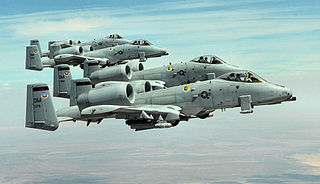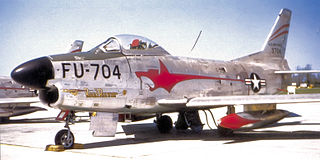
The 355th Fighter Squadron, nicknamed the Fightin' Falcons, is a United States Air Force unit stationed at Eielson Air Force Base, Alaska. It is an active-duty unit assigned to the 354th Fighter Wing and operates the Lockheed Martin F-35A Lightning II. The squadron is tasked with the Suppression of Enemy Air Defenses. Between 2015 and 2019, the unit's assignment was that of a subordinate unit of the 495th Fighter Group based at Naval Air Station Joint Reserve Base Fort Worth in Texas, flying the General Dynamics F-16C/D Fighting Falcon.

The 80th Flying Training Wing is a wing of the United States Air Force based out of Sheppard Air Force Base in Wichita Falls, Texas.

The 355th Wing is a United States Air Force unit assigned to the Air Combat Command's Fifteenth Air Force. It is stationed at Davis–Monthan Air Force Base in Tucson, Arizona, where it operates the A-10 Thunderbolt II. The wing's mission is to provide close air support (CAS), air interdiction (AI), forward air control (FAC), combat search and rescue (CSAR), ground-based tactical air control, and airbase operations.

The 388th Fighter Wing (388FW) is a United States Air Force unit assigned to the Air Combat Command Fifteenth Air Force. The unit is stationed at Hill Air Force Base, Utah.

The 507th Air Refueling Wing is a reserve component flying unit of the United States Air Force. It is assigned to Fourth Air Force of Air Force Reserve Command, stationed at Tinker Air Force Base, Oklahoma with elements at Altus Air Force Base, Oklahoma. The 507th ARW executes air refueling, airlift, and training in support of Air Mobility Command and U.S. Strategic Command's national emergency war order requirements. The wing employs approximately 1,100 men and women made up of a mix of Traditional Reservists, full-time Air Reserve Technicians, AGRs and Air Force civilians. The wing also provides mission support for all other reserve units stationed at Tinker AFB.

The 136th Attack Squadron is a unit of the New York Air National Guard 107th Attack Wing located at Niagara Falls Joint Air Reserve Station, New York. The 136th is equipped with the MQ-9 Reaper. If activated to federal service, the Wing is gained by the United States Air Force's Air Combat Command.

The 47th Fighter Squadron is an Air Force Reserve Command unit based at Davis–Monthan Air Force Base, Arizona, where it flies Fairchild Republic A-10 Thunderbolt II aircraft and is assigned to the 924 Fighter Group.

The 114th Fighter Squadron is a unit of the Oregon Air National Guard 173d Fighter Wing located at Kingsley Field Air National Guard Base, Klamath Falls, Oregon. The 114th is equipped with the McDonnell Douglas F-15C Eagle.

The 354th Fighter Squadron is part of the 355th Fighter Wing at Davis–Monthan Air Force Base, Arizona. It operates A-10 Thunderbolt II aircraft conducting close air support missions.

The 357th Fighter Squadron is part of the 355th Fighter Wing at Davis–Monthan Air Force Base, Arizona. It operates Fairchild Republic A-10 Thunderbolt II aircraft training pilots for close air support missions.

The 465th Air Refueling Squadron is a United States Air Force Reserve squadron, assigned to the 507th Operations Group, 507th Air Refueling Wing, stationed at Tinker Air Force Base, Oklahoma. The squadron operates the KC-135R aircraft conducting aerial refueling missions.

The 97th Flying Training Squadron is part of the 340th Flying Training Group and is the Reserve associate to the 80th Flying Training Wing based at Sheppard Air Force Base, Texas.

The 562nd Flying Training Squadron is an inactive United States Air Force unit. It was part of the 12th Flying Training Wing at Randolph Air Force Base, Texas, where it operated the Boeing T-43 Bobcat conducting navigator training from 1993 until inactivating on 19 November 2010.

The 46th Fighter Training Squadron is an inactive United States Air Force unit. Its last assignment was with the 917th Operations Group at Barksdale Air Force Base, Louisiana. where it was inactivated on 1 October 1993.

The 496th Tactical Fighter Squadron is an inactive United States Air Force unit, last assigned to the United States Air Forces in Europe, 50th Tactical Fighter Wing, being stationed at Hahn Air Base, Germany. The squadron was inactivated on 15 May 1991.

McGhee Tyson Air National Guard Base is a joint military facility located at McGhee Tyson Airport. It is located approximately 10 miles (16 km) south of the central business district of Knoxville, near Alcoa, Tennessee. It was the site of McGhee Tyson Air Force Base from 1952 until 1960.

The 516th Air Defense Group is a disbanded United States Air Force organization. Its last assignment was with the 35th Air Division at McGhee Tyson Airport, Tennessee. It was inactivated on 18 August 1955.

The 325th Operations Group is the flying component of the 325th Fighter Wing, assigned to Air Combat Command of the United States Air Force. The group is stationed at Tyndall Air Force Base, Florida. It conducts training on the Lockheed Martin F-22 Raptor and commands one operational Raptor squadron. It directs the flying and support operations of two F-22 squadrons, a fighter training squadron, an operations support squadron and a training support squadron.

The 355th Tactical Airlift Squadron is an inactive United States Air Force unit. Its last assignment was with 906th Tactical Airlift Group stationed at Rickenbacker Air National Guard Base, Ohio. It was inactivated on 1 July 1982.

The 333d Special Operations Wing is an inactive United States Air Force unit. It was active from July 1968 through March 1970 at Pleiku Air Base, South Vietnam. In 1985, the wing was consolidated with the 333d Bombardment Group as the 333d Special Operations Wing.

































